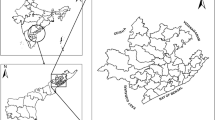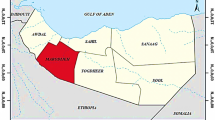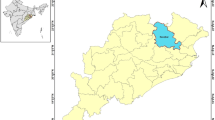Abstract
Malaria is an endemic disease in India and targeted to eliminate by the year 2030. The present study is aimed at understanding the epidemiological patterns of malaria transmission dynamics in Assam and Arunachal Pradesh followed by the development of a malaria prediction model using monthly climate factors. A total of 144,055 cases in Assam during 2011–2018 and 42,970 cases in Arunachal Pradesh were reported during the 2011–2019 period observed, and Plasmodium falciparum (74.5%) was the most predominant parasite in Assam, whereas Plasmodium vivax (66%) in Arunachal Pradesh. Malaria transmission showed a strong seasonal variation where most of the cases were reported during the monsoon period (Assam, 51.9%, and Arunachal Pradesh, 53.6%). Similarly, the malaria incidence was highest in the male population in both states (Asam, 55.75%, and Arunachal Pradesh, 51.43%), and the disease risk is also higher among the > 15 years age group (Assam, 61.7%, and Arunachal Pradesh, 67.9%). To predict the malaria incidence, Bayesian structural time series (BSTS) and Seasonal Auto-Regressive Integrated Moving Average with eXogenous factors (SARIMAX) models were implemented. A statistically significant association between malaria cases and climate variables was observed. The most influencing climate factors are found to be maximum and mean temperature with a 6-month lag, and it showed a negative association with malaria incidence. The BSTS model has shown superior performance on the optimal auto-correlated dataset (OAD) which contains auto-correlated malaria cases, cross-correlated climate variables besides malaria cases in both Assam (RMSE, 0.106; MAE, 0.089; and SMAPE, 19.2%) and Arunachal Pradesh (RMSE, 0.128; MAE, 0.122; and SMAPE, 22.6%) than the SARIMAX model. The findings suggest that the predictive performance of the BSTS model is outperformed, and it may be helpful for ongoing intervention strategies by governmental and nongovernmental agencies in the northeast region to combat the disease effectively.







Similar content being viewed by others
Data availability
The data and materials are available with the corresponding author and will be provided upon request.
References
Abiodun GJ, Makinde OS, Adeola AM, Njabo KY, Witbooi PJ, Djidjou-Demasse R, Botai JO (2019) A dynamical and zero-inflated negative binomial regression modelling of malaria incidence in Limpopo province, south Africa. Int J Environ Res Public Health 16(11):2000. https://doi.org/10.3390/ijerph16112000
Beck-Johnson LM, Nelson WA, Paaijmans KP, Read AF, Thomas MB, Bjørnstad ON (2013) The effect of temperature on Anopheles mosquito population dynamics and the potential for malaria transmission. PLoS ONE 8(11):e79276
Brodersen KH, Gallusser F, Koehler J, Remy N, Steven L (2015) Scott. Inferring causal impact using Bayesian structural time-series models. Ann Appl Stat 9(1):247–274. https://doi.org/10.1214/14-AOAS788
Das NG, Dhiman S, Talukdar PK, Goswami D, Rabha B, Baruah I, Veer V (2015) Role of asymptomatic carriers and weather variables in persistent transmission of malaria in an endemic district of Assam, India. Infect Ecol Epidemiol 5(1):25442
Das NG, Talukdar PK, Kalita J, Baruah I, Sribastava RB (2007) Malaria situation in forest-fringed villages of Sonitpur district (Assam), India bordering Arunachal Pradesh during an outbreak. J Vector Borne Dis 44(3):213
Dev V, Dash AP, Khound K (2006) High-risk areas of malaria and prioritizing interventions in Assam. Curr Sci 90:32–36
Dev V, Manguin S (2021) Defeating malaria in the North-East region: the forerunner for malaria elimination in India. Acta Trop 222:106040. https://doi.org/10.1016/j.actatropica.2021.106040
Dev V, Sharma VP, Barman K (2015) Mosquito-borne diseases in Assam, north-east India: current status and key challenges. WHO South-East Asia J Public Health 4(1):20–29
Dev V, Sharma VP (2013) The dominant mosquito vectors of human malaria in India. In (Ed.), Anopheles mosquitoes - New insights into malaria vectors. IntechOpen. https://doi.org/10.5772/55215
Dev V (1996) Anopheles minimus: its bionomics and role in transmission of malaria in Assam, India. Bull World Health Organ 74:61–66
Dhiman S, Baruah I, Singh L (2010) Military malaria in northeast region of India. Def Sci J 60(2):213
Dikshit KR, Dikshit JK (2014) Relief features of north-east India. In: Dikshit KR, Dikshit JK (eds) north-east India: land, people and economy. Springer, Netherlands, Dordrecht, The Netherlands, pp 91–125
Dorigo WA et al (2017) ESA CCI soil moisture for improved earth system understanding: state-of-the art and future directions. Remote Sens Environ 15:185–215. https://doi.org/10.1016/j.rse.2017.07.001
Dua VK, Dev V, Phookan S, Gupta NC, Sharma VP, Subbarao SK (2003) Multi-drug resistant Plasmodium falciparum malaria in Assam, India: timing of recurrence and anti-malarial drug concentrations in whole blood. Am J Trop Med Hyg 69(5):555–557
Dutta P, Khan SA, Bhattarcharyya DR, Khan AM, Sharma CK, Mahanta J (2010) Studies on the breeding habitats of the vector mosquito Anopheles baimai and its relationship to malaria incidence in northeastern region of India. Breeding habitats ofAnopheles baimai and its role in incidence of malaria in northeastern region of India. EcoHealth 7:498–506
Feroze N (2020) Forecasting the patterns of COVID-19 and causal impacts of lockdown in top five affected countries using Bayesian structural time series models. Chaos, Solitons Fractals 140:110196
George EI, McCulloch RE (1997) Approaches for Bayesian variable selection. Stat Sin 7:339–373
George EI, McCulloch RE (1993) Variable selection via Gibbs sampling. J Amer Stat Assoc 88:881–889. https://doi.org/10.1080/01621459.1993.10476353
Gething PW, Smith DL, Patil AP, Tatem AJ, Snow RW, Hay SI (2010) Climate change and the global malaria recession. Nature 465:342–345. https://doi.org/10.1038/nature09098
Ghosh SK, Rahi M (2019) Malaria elimination in India-the way forward. J Vector Borne Dis 56(1):32–40
Goswami P, Murty US, Mutheneni SR, Krishnan ST (2014) Relative roles of weather variables and change in human population in malaria: comparison over different states of India. PLoS ONE 9(6):e99867. https://doi.org/10.1371/journal.pone.0099867
Goswami P, Murty US, Mutheneni SR, Kukkuthady A, Krishnan ST (2012) A model of malaria epidemiology involving weather, exposure and transmission applied to north east India. PLoS ONE 7(11):e49713. https://doi.org/10.1371/journal.pone.0049713
Gruber A, Scanlon T, van der Schalie R, Wagner W, Dorigo W (2019) Evolution of the CCI soil moisture climate data records and their underlying merging methodology. Earth Syst Sci Data 11:717–739. https://doi.org/10.5194/essd-11-717-2019
Hoeting JA, Madigan D, Raftery AE, Volinsky CT (1999) Bayesian model averaging: a tutorial (with comments by M. Clyde, David Draper and EI George, and a rejoinder by the authors. Stat Sci 14(4):382–417
Ishwaran H, Rao JS (2005) Spike and slab variable selection: frequentist and Bayesian strategies. Ann Statist 33:730–773
Kalnay E, Kanamitsu M, Kistler R, Collins W, Deaven D, Gandin L, Joseph D (1996) The NCEP/NCAR 40-year reanalysis project. Bull Am Meteor Soc 77(3):437–472
Karuppusamy B, Sarma DK, Lalmalsawma P, Pautu L, KarmodiyaK NPB (2021) Effect of climate change and deforestation on vector borne diseases in the north-eastern Indian state of Mizoram bordering Myanmar. J Clim Change Health 2:100015. https://doi.org/10.1016/j.joclim.2021.100015
Kumar P, Pisudde P, Sarthi PP (2022) Meteorological linkage of Malaria cases in the eastern state of India. J Clim Change Health 5:100064. https://doi.org/10.1016/j.joclim.2021.100064
Kumar P, Vatsa R, Sarthi PP, Kumar M, Gangare V (2020) Modeling an association between malaria cases and climate variables for Keonjhar district of Odisha, India: A Bayesian approach. J Parasit Dis 44(2):319
Kumar V, Mangal A, Panesar S, Yadav G, Talwar R, Raut D, Singh S (2014) Forecasting malaria cases using climatic factors in delhi, India: a time series analysis. Malar Res Treat 482851https://doi.org/10.1155/2014/482851
Lauderdale JM, Caminade C, Heath AE, Jones AE, MacLeod DA, Gouda KC, Murty US, Goswami P, Mutheneni SR, Morse AP (2014) Towards seasonal forecasting of malaria in India. Malar J 13:310. https://doi.org/10.1186/1475-2875-13-310
Lee E, Burkhart J, Olson S, Billings AA, Patz JA, Harner EJ (2016) Relationships of climate and irrigation factors with malaria parasite incidences in two climatically dissimilar regions in India. J Arid Environ 124:214–224
Nath MJ, Bora A, Talukdar PK, Das NG, Dhiman S, Baruah I, Singh L (2012) A longitudinal study of malaria associated with deforestation in Sonitpur district of Assam, India. Geocarto Int 27(1):79–88. https://doi.org/10.1080/10106049.2011.613485
Mohapatra PK, Prakash A, Bhattacharyya DR, Goswami BK, Ahmed A, Sarmah B, Mahanta J (2008) Detection & molecular confirmation of a focus of Plasmodium malariae in Arunachal Pradesh, India. Indian J Med Res 128:52–56
Mopuri R, Kakarla SG, Mutheneni SR, Kadiri MR, Kumaraswamy S (2020) Climate based malaria forecasting system for Andhra Pradesh, India. J Parasit Dis 44(3):497–510. https://doi.org/10.1007/s12639-020-01216-6
Mutheneni SR, Upadhyayula SM, Kadiri MR, Nishing K (2014) Malaria prevalence in Arunachal Pradesh-a northeastern state of India. Am J Trop Med Hyg 91:1088–1093
Nath DC, Mwchahary DD (2013) Association between climatic variables and malaria incidence: a study in Kokrajhar District of Assam, India: climatic variables and malaria incidence in Kokrajhar District. Global J Health Sci 5(1):90
Nordmann T, Borrmann S, Ramharter M (2021) Drug-induced hypersensitivity to artemisinin-based therapies for malaria. Trends Parasitol S1471–4922(21):00224–00225. https://doi.org/10.1016/j.pt.2021.08.011
NVBDCP [National Vector Borne Disease Control Programme]-2021. Malaria situation in India. Available from: http://nvbdcp.gov.in. [accessed on Dec 19, 2021].
Paaijmans KP, Imbahale SS, Thomas MB, Takken W (2010) Relevant microclimate for determining the development rate of malaria mosquitoes and possible implications of climate change. Malar J 9:196
Paaijmans KP, Thomas MB (2011) The influence of mosquito resting behavior and associated micro climate for malaria risk. Malar J 10:183
Pai DS, Rajeevan M, Sreejith OP, Mukhopadhyay B, Satbha NS (2014) Development of a new high spatial resolution (0.25° × 0.25°) long period (1901-2010) daily gridded rainfall data set over India and its comparison with existing data sets over the region. MAUSAM 65(1):1–18. https://doi.org/10.54302/mausam.v65i1.851
Patz JA, McGeehin MA, Bernard SM, Ebi KL, Epstein PR, Grambsch A, Gubler DJ, Reither P, Romieu I, Rose JB, Samet JM, Trtanj J (2000) The potential health impacts of climate variability and change for the United States: executive summary of the report of the health sector of the U.S. National Assessment. Environ Health Perspect. 108(4):367–376. https://doi.org/10.1289/ehp.00108367
Prakash A, Bhattacharya DR, Mohapatra PK, Mahanta J (1998) Anopeline fauna in the northeastern states of India with notes on vectors of malaria. Proc Natl Acad Sci India 68:217–228
Prakash A, Mohapatra P, Bhattacharyya D, Goswami BK, Mahanta J (2003) Plasmodium ovale: First case report from Assam, India. Curr Sci 84:1187–1188
Rabha B, Goswami D, Dhiman S, Das NG, Talukdar PK, Nath MJ, Baruah I, Bhola RK, Singh L (2012) A cross sectional investigation of malaria epidemiology among seven tea estates in Assam, India. J Parasit Dis 36(1):1–6
Raghavendra K, Velamuri PS, Verma V, Elamathi N, Barik TK, Bhatt RM, Dash AP (2017) Temporo-spatial distribution of insecticide-resistance in Indian malaria vectors in the last quarter-century: need for regular resistance monitoring and management. J Vector Borne Dis 54(2):111
Ranjha R, Sharma A (2021) Forest malaria: the prevailing obstacle for malaria control and elimination in India. BMJ Glob Health 6(5):e005391. https://doi.org/10.1136/bmjgh-2021-005391
Sarma DK, Mohapatra PK, Bhattacharyya DR, Chellappan S, Karuppusamy B, Barman K, Senthil Kumar N, Dash AP, Prakash A, Balabaskaran Nina P (2019) Malaria in north-east India: importance and implications in the Era of elimination. Microorganisms 7(12):673. https://doi.org/10.3390/microorganisms7120673
Scott SL, Varian HR (2014) Predicting the present with Bayesian structural time series. Int J Math Model Numer Optim 5(1–2):4–23
Sehgal PN, Sharma MI, Sharma SL, Gogai S (1973) Resistance to chloroquine in falciparum malaria in Assam State, India. J Commun Dis 5(4):175–180
Sharma RK, Rajvanshi H, Bharti PK, Nisar S, Jayswar H, Mishra AK, Saha KB, Shukla MM, Das A, Kaur H, Wattal SL (2021) Socio-economic determinants of malaria in tribal dominated Mandla district enrolled in Malaria Elimination Demonstration Project in Madhya Pradesh. Malar J 20(1):1–3
Smith TG, et al (2017) pmdarima: ARIMA estimators for Python. http://www.alkaline-ml.com/pmdarima
Srivastava AK, Rajeevan M, Kshirsagar SR (2009) Development of high resolution daily gridded temperature data set (1969–2005) for the Indian region. Atmos Sci Let 10:249–254. https://doi.org/10.1002/asl.232
Stoddard ST, Morrison AC, Vazquez-Prokopec GM, Soldan VP, Kochel TJ, Kitron U, Elder JP, Scott TW (2009) The role of human movement in the transmission of vector-borne pathogens. PLoS Negl Trop Dis 3(7):e481
Umer MF, Zofeen S, Majeed A, Hu W, Qi X, Zhuang G (2019) Effects of socio-environmental factors on malaria infection in Pakistan: a Bayesian spatial analysis. Int J Environ Res Public Health 16(8):1365
Upadhyayula SM, Mutheneni SR, Chenna S, Parasaram V, Kadiri MR (2015) Climate drivers on malaria transmission in Arunachal Pradesh, India. PLoS ONE 10(3):e0119514. https://doi.org/10.1371/journal.pone.0119514
World malaria report (2020) 20 years of global progress and challenges. World Health Organ. Accessed 5 Nov 2019
Acknowledgements
The authors are grateful to the directors of the Council of Scientific and Industrial Research-Indian Institute of Chemical Technology, Hyderabad, and 4PI, Bangalore, for their encouragement and support. Suryanarayana Murty Upadhyayula acknowledges the support from the Ministry of Chemicals and Fertilizers, Govt. of India. Srinivasa Rao Mutheneni is grateful to the MoEF & CC (Ministry of Environment Forest & Climate Change), Govt. India, for an environmental information system (ENVIS) and Center for Climate Change and Public Health. The funders had no role in study design, data collection and analysis, decision to publish, or preparation of the manuscript. CSIR-IICT communication number of the article is IICT/pubs./2022/057.
Funding
The present work is supported by the DST (Department of Science and Technology) under the Epidemiology Data Analytics (EDA) of Interdisciplinary cyber-physical systems (ICPS) program (Grant number: DST/ICPS/EDA/2018), Govt. of India.
Author information
Authors and Affiliations
Contributions
All authors contributed to the study design, data analysis, and manuscript preparation. HV, NY, PKK, RU, and MRK are involved in data compilation and pre-processing, RM is involved for spatial mapping. HV and SRM are involved in data analysis and draft manuscript preparation. KCG, KRB, and SMU are involved in draft manuscript correction. Overall work was supervised by SRM.
Corresponding author
Ethics declarations
Ethics approval
Not applicable.
Consent to participate
Not applicable.
Consent for publication
Not applicable.
Competing interests
The authors declare no competing interests.
Additional information
Responsible Editor: Lotfi Aleya
Publisher's note
Springer Nature remains neutral with regard to jurisdictional claims in published maps and institutional affiliations.
Supplementary Information
Below is the link to the electronic supplementary material.
Rights and permissions
About this article
Cite this article
Vavilala, H., Yaladanda, N., Krishna Kondeti, P. et al. Weather integrated malaria prediction system using Bayesian structural time series model for northeast states of India. Environ Sci Pollut Res 29, 68232–68246 (2022). https://doi.org/10.1007/s11356-022-20642-y
Received:
Accepted:
Published:
Issue Date:
DOI: https://doi.org/10.1007/s11356-022-20642-y




